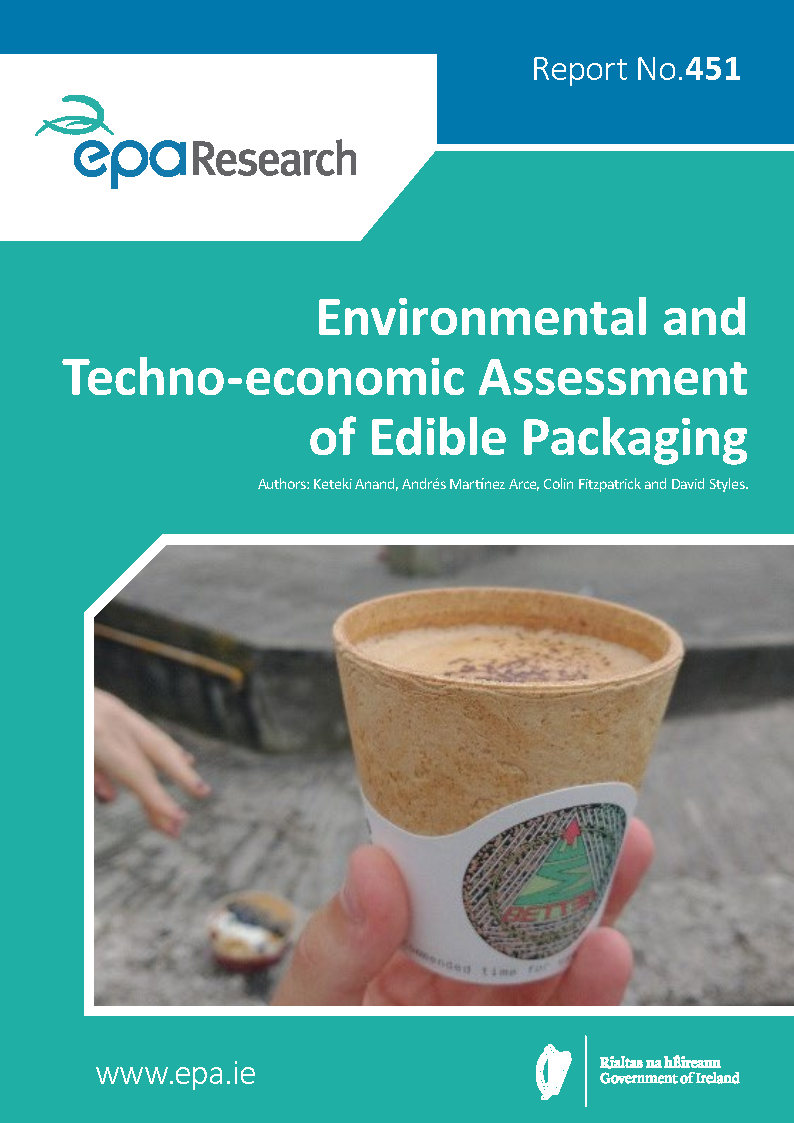Research 451: Environmental and Techno-economic Assessment of Edible Packaging
Authors: Keteki Anand, Andrés Martínez Arce, Colin Fitzpatrick and David Styles
Summary: It is estimated that 550,000 cups per day are used in the Irish market alone, and that this could increase to an annual total of 300 million cups per year by 2025. Although there is a common perception among consumers that paper cups are recyclable, and thus a sustainable option, this is not necessarily true. These cups are lined with plastic, which is difficult to separate from the paper, and most paper cups are sent to residual waste streams for landfill or incineration. The concept of edible packaging has the potential to help address littering and waste management challenges from single-use disposable cups. EAT-Packaging undertook a life cycle assessment across a range of relevant cup types and engaged with national stakeholders to develop scenarios to identify where, when, and how edible cups (or alternative options) could reduce environmental impact for the functional unit of a cup containing a single drink.

Project highlights video
Identifying pressures
Single-use disposable cups are a major feature of daily lives in Ireland. The time-saving and portability benefits, as well as an overall growing demand for coffee, have increased their usage significantly. It is estimated that 550,000 cups per day are used in the Irish market alone, and this could increase to an annual total of 300 million cups per year by 2025. Although there is a common perception among consumers that paper cups are recyclable, and thus a sustainable option, this is not necessarily true. These cups are lined with plastic, which is difficult to separate from the paper, and most paper cups are sent to residual waste streams for landfill or incineration. Disposable cups also make up a significant portion of litter. Reusable cups are an important part of the solution but may not be practical in all situations. Hence there is strong interest in the concept of edible packaging that could avoid littering and waste management burdens.
Informing policy
EAT-Packaging undertook a life cycle assessment across a range of relevant cup types and pertinent scenarios to identify where, when and how edible cups (or alternative options) could reduce environmental impact for the functional unit of a cup containing a single drink of coffee.
Edible cups are not a panacea and can have a higher environmental impact than conventional single-use cups. However, in the right situations, edible cups can be the lowest impact option. It may be appropriate to promote edible cups carefully in situations where they are likely to displace disposable cups, reduce littering and substitute other snacks. Promising scenarios identified by stakeholders include outdoor festivals, mobile markets, schools, cruise ships and beach cafes. Deployment in schools could play a dual educational role and encourage wider behaviour change. The comparatively high price of edible cups suggests that marketing them as a combined cup and snack could be an important strategy.
Developing solutions
Results from the techno-economic and life cycle assessments of various cup types support the following recommendations:
• Policymakers could increase efforts to encourage widespread and repeated use of reusable cups.
• Rinsing cups with cold water after each use, combined with a periodic full wash (in a dishwasher), minimises impact from an
energy and environmental standpoint.
• Further clarity is needed to determine the status of edible cups from a regulatory perspective; specifically, whether they need to
comply with both food and packaging regulations. Appropriate guidelines on transparent labelling will be needed.
• Clear guidelines are also needed to ensure sanitary handling measures at point of sale of edible cups, to avoid crosscontamination affecting consumers.
• Brown bins could be easily accessible at sales locations so that consumers can appropriately dispose of uneaten edible cups (the
next best disposal options from an environmental perspective are animal feed, anaerobic digestion or composting).
https://www.epa.ie/media/epa-2020/research/research-publications/EPA-Report-Cover-451.jpg